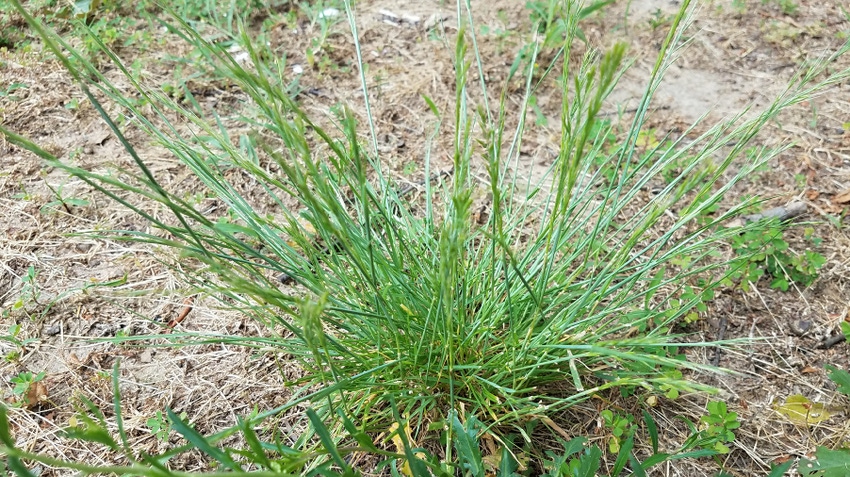April 9, 2024

Mike Trammell, Oklahoma State University
Crabgrass is an annual, warm-season grass that is fast growing, easy to establish, and capable of natural and prolific reseeding, all of which allows it to excel as a “weed.”
Despite its bad reputation, crabgrass was originally used in Europe as fodder before being introduced into the United States, likely around the mid-1800s, as a forage for grazing livestock. During the past 30 years or so, there has been an enormous change in the perception of crabgrass with forage and livestock producers. It is now considered a legitimate forage crop.
Crabgrass promotion
In 1988, the Noble Research Institute was the first to publicly release a crabgrass cultivar, which was named Red River. During its history, Red River crabgrass became the main commercial cultivar, promoting the use of crabgrass as an important warm-season annual grass for forage and livestock operations. This initially occurred in the southern Great Plains but now has spread throughout the southern United States. Since then a handful of new forage crabgrass cultivars have been developed and released.
These improved crabgrass varieties are not weeds’ but high-producing, high-quality forages that are broadly adapted. The nutritive value of crabgrass is often superior to other warm-season forage options during summer for both haying and grazing. Forage crabgrass has high crude protein (8-14%) and high digestibility, which promotes average daily gains of livestock that can easily reach 2 pounds per head per day. It is also an excellent choice in many double-cropping systems, especially with winter annual forages like wheat, to extend the grazing period.
Reducing costs
Crabgrass is widely adapted and can be used in both till and no-till forage production systems and is often managed in many livestock grazing operations as a reseeding crop, thereby reducing the cost of seed and other annual costs. In addition, crabgrass can also be used as a component in warm-season annual and perennial forage systems. It is particularly productive in dryland situations, but it also performs well under irrigation and across a range of soil pH levels (5 to 7.5). It can be used for silage or hay production and is an excellent choice for conservation purposes. It covers critical areas quickly due to its rapid growth and establishment.
Large clumps
Crabgrass seed is light and fluffy which can interfere with its ability to flow through a seed drill. Crabgrass seeds are rough in texture, resulting in individual seeds sticking together to form large clumps. The clumps not only cause problems when drilling but with the broadcasting of seed as well. To overcome these issues, crabgrass seed is sometimes mixed with a carrier, such as a fertilizer, to aid in seed flow through the machine when planting. Planting coated seed is also an option. Coated seed can also improve establishment results by adding bulk and weight to the seed, allowing it to be easily drilled or broadcast.
For best results, plant crabgrass mid-spring to early summer for the best forage production. Since yield is dependent on rainfall, avoid planting after mid-summer. Seeding rates should range from 4 to 6 pounds of pure live seed (PLS) per acre and planting depth should be 1/4-inch deep. Crabgrass’ excellent ability to reseed makes re-establishment each year easy, which can potentially reduce costs; however, it is recommended to add low rates of additional seed annually to the production system. Adequate fertility must be provided for improved forages to be successful, and crabgrass is no exception. Always soil test and apply nitrogen, phosphorus and potassium accordingly.
Crabgrass works well when planted following small grains such as cereal rye or wheat. The small grains provide forage for late fall into spring and the crabgrass fills in during the summer and early fall to provide high-quality forage. Light tillage is recommended when the cereal forage is done being grazed or harvested in the spring. This improves seed germination and promotes better volunteer crabgrass stands for the summer.
Hay production
In the summer, begin grazing crabgrass stands when plants are 4 to 6 inches tall, which typically occurs 30-40 days after seedling emergence. For hay production, cut crabgrass pastures in the boot to heading stage (normally 18 to 24 inches high), which will allow for at least two harvests per year. Regrowth is supported by remaining leaves and not by stored root and crown reserves, so avoid cutting crabgrass pastures lower than 3 inches.
Crabgrass has been building momentum in the last couple of years, and I suspect that it is due to those producers willing enough to try something “off the wall.” Afterall, this weed has great potential to extend the grazing season and provide nutrient-dense forage to grazing livestock.
You May Also Like




